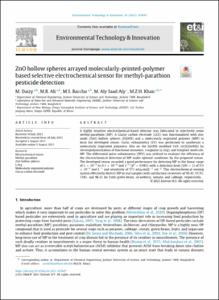ZnO hollow spheres arrayed molecularly-printed-polymer based selective electrochemical sensor for methyl-parathion pesticide detection
- Title
- ZnO hollow spheres arrayed molecularly-printed-polymer based selective electrochemical sensor for methyl-parathion pesticide detection
- Author(s)
- Daizy, M. ; Ali, M.R. ; Bacchu, M.S. ; Aly, Mohamed Aly Saad ; Khan, M.Z.H.
- Issued Date
- 2021-11
- Citation
- Environmental Technology and Innovation, v.24, no.101847
- Type
- Article
- Author Keywords
- L-Arg ; Methyl-parathion ; Molecularly imprinted polymer ; ZnO hollow spheres ; Electrochemical sensor ; Glassy carbon electrode
- Keywords
- ELectrochemical detection ; Electrochemical sensing ; Glassy carbon electrodes ; Methyl-parathion pesticides ; Molecularly imprinted ; Molecularly Imprinted Polymer ; Optimal conditions ; Electrochemical sensors ; Arginine ; Chemical detection ; Cyclic voltammetry ; Electropolymerization ; Glass membrane electrodes ; II-VI semiconductors ; Oxide minerals ; Synthesis (chemical) ; Zinc oxide ; Differential pulse voltammetry
- ISSN
- 2352-1864
- Abstract
- A highly sensitive electrochemical-based detector was fabricated to selectively sense methyl-parathion (MP). A Glassy carbon electrode (GCE) was functionalized with zinc oxide (ZnO) hollow spheres (ZnOHS) and a molecularly imprinted polymer (MIP) to form the developed sensor. Cyclic voltammetry (CV) was performed to synthesize a molecularly imprinted polymeric film on the ZnOHS modified GCE (GCE/ZnOHS) by electropolymerization of functional monomer, l-arginine (L-Arg), and template molecule, MP. The differential pulse voltammetry (DPV) was utilized to evaluate the efficiency of the electrochemical detection of MP under optimal conditions by the proposed sensor. The developed sensor recorded a good performance for detecting MP in the linear range of 5 × 10−9 to 0.1 × 10−4 mol L−1 (R2=0.985) with a detection limit (S/N = 3) of 0.5 × 10−9 mol L−1 and sensitivity of 571 nA/μmolL −1 cm −2. This electrochemical sensing system effectively detects MP in real samples with satisfactory recoveries of 90.4%, 91.9%, 118%, and 96.3% for fresh green beans, strawberry, tomato, and cabbage, respectively. © 2021 Elsevier B.V.
- Publisher
- Elsevier BV
- Files in This Item:
-
 기타 데이터 / 1.76 MB / Adobe PDF
download
기타 데이터 / 1.76 MB / Adobe PDF
download
- Appears in Collections:
- ETC 1. Journal Articles



